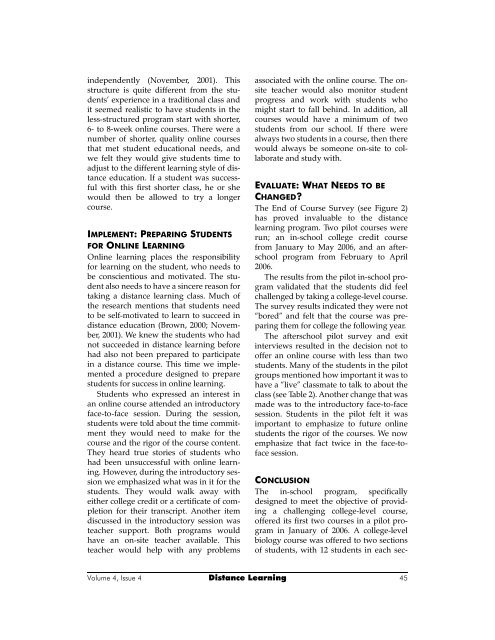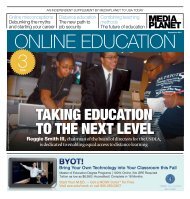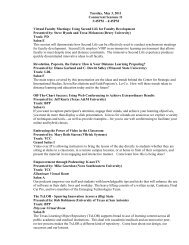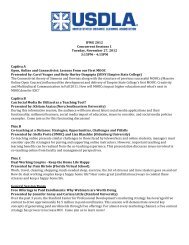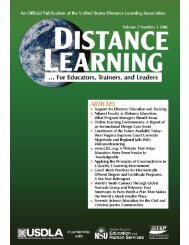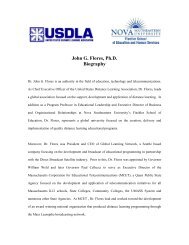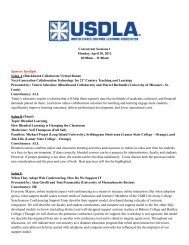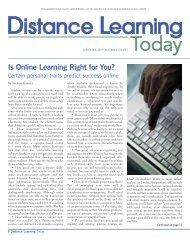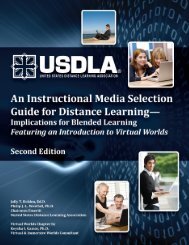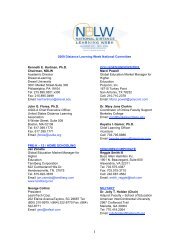United States Distance Learning Association
United States Distance Learning Association
United States Distance Learning Association
- No tags were found...
Create successful ePaper yourself
Turn your PDF publications into a flip-book with our unique Google optimized e-Paper software.
independently (November, 2001). This<br />
structure is quite different from the students’<br />
experience in a traditional class and<br />
it seemed realistic to have students in the<br />
less-structured program start with shorter,<br />
6- to 8-week online courses. There were a<br />
number of shorter, quality online courses<br />
that met student educational needs, and<br />
we felt they would give students time to<br />
adjust to the different learning style of distance<br />
education. If a student was successful<br />
with this first shorter class, he or she<br />
would then be allowed to try a longer<br />
course.<br />
IMPLEMENT: PREPARING STUDENTS<br />
FOR ONLINE LEARNING<br />
Online learning places the responsibility<br />
for learning on the student, who needs to<br />
be conscientious and motivated. The student<br />
also needs to have a sincere reason for<br />
taking a distance learning class. Much of<br />
the research mentions that students need<br />
to be self-motivated to learn to succeed in<br />
distance education (Brown, 2000; November,<br />
2001). We knew the students who had<br />
not succeeded in distance learning before<br />
had also not been prepared to participate<br />
in a distance course. This time we implemented<br />
a procedure designed to prepare<br />
students for success in online learning.<br />
Students who expressed an interest in<br />
an online course attended an introductory<br />
face-to-face session. During the session,<br />
students were told about the time commitment<br />
they would need to make for the<br />
course and the rigor of the course content.<br />
They heard true stories of students who<br />
had been unsuccessful with online learning.<br />
However, during the introductory session<br />
we emphasized what was in it for the<br />
students. They would walk away with<br />
either college credit or a certificate of completion<br />
for their transcript. Another item<br />
discussed in the introductory session was<br />
teacher support. Both programs would<br />
have an on-site teacher available. This<br />
teacher would help with any problems<br />
associated with the online course. The onsite<br />
teacher would also monitor student<br />
progress and work with students who<br />
might start to fall behind. In addition, all<br />
courses would have a minimum of two<br />
students from our school. If there were<br />
always two students in a course, then there<br />
would always be someone on-site to collaborate<br />
and study with.<br />
EVALUATE: WHAT NEEDS TO BE<br />
CHANGED<br />
The End of Course Survey (see Figure 2)<br />
has proved invaluable to the distance<br />
learning program. Two pilot courses were<br />
run; an in-school college credit course<br />
from January to May 2006, and an afterschool<br />
program from February to April<br />
2006.<br />
The results from the pilot in-school program<br />
validated that the students did feel<br />
challenged by taking a college-level course.<br />
The survey results indicated they were not<br />
“bored” and felt that the course was preparing<br />
them for college the following year.<br />
The afterschool pilot survey and exit<br />
interviews resulted in the decision not to<br />
offer an online course with less than two<br />
students. Many of the students in the pilot<br />
groups mentioned how important it was to<br />
have a “live” classmate to talk to about the<br />
class (see Table 2). Another change that was<br />
made was to the introductory face-to-face<br />
session. Students in the pilot felt it was<br />
important to emphasize to future online<br />
students the rigor of the courses. We now<br />
emphasize that fact twice in the face-toface<br />
session.<br />
CONCLUSION<br />
The in-school program, specifically<br />
designed to meet the objective of providing<br />
a challenging college-level course,<br />
offered its first two courses in a pilot program<br />
in January of 2006. A college-level<br />
biology course was offered to two sections<br />
of students, with 12 students in each sec-<br />
Volume 4, Issue 4 <strong>Distance</strong> <strong>Learning</strong> 45


